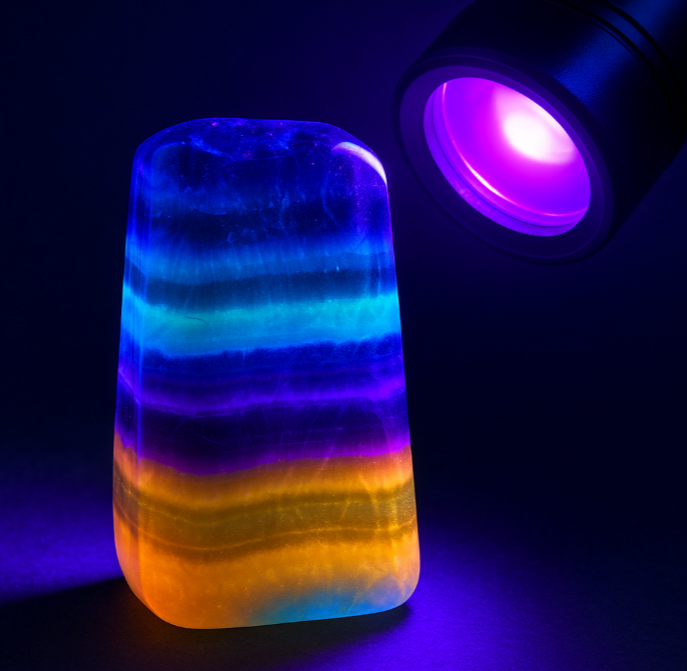
Rainbow Fluorite: How to Spot Real vs Fake and What Makes It So Special
Share
Rainbow Fluorite: How to Spot Real vs Fake and What Makes It So Specia
Rainbow fluorite is one of the most visually stunning and widely loved crystals on the market—but how can you tell if it’s real?
In this guide, we’ll explore how to identify authentic rainbow fluorite, expose common fake techniques, and dive into its origins, value, and uses in meditation and yoga practices.
What Is Rainbow Fluorite?
A Naturally Layered Calcium Fluoride
Rainbow fluorite is a calcium fluoride mineral (CaF₂) that forms in cubic or octahedral crystals.
What sets it apart is its striking banded coloration—typically shades of purple, green, blue, and sometimes yellow.
These layers occur due to trace impurities and changes in formation temperature during crystallization, making each piece naturally unique.

A Stone With Ancient Roots
Fluorite has been mined since ancient times. The Romans used it to carve elaborate drinking vessels, believing it prevented drunkenness. The name "fluorite" comes from the Latin word fluere ("to flow"), referring to its use as a flux in metal smelting.
Today, rainbow fluorite is prized not only for its beauty but also for its spiritual and metaphysical qualities.
How to Tell If Rainbow Fluorite Is Real
1. Look Closely at the Banding
- Real rainbow fluorite has subtle, uneven layers that may appear slightly translucent.
- Fakes (often glass or dyed quartz) tend to have overly bright, uniform, or blurry color zones.
2. Check the Surface Feel
- Authentic fluorite feels cool, smooth, and slightly soft (Mohs hardness: 4).
- Fake versions made of resin or glass are often warmer to the touch and too lightweight.
3. Light Test
Hold the stone up to natural light:
- Real fluorite reveals distinct layers and slight internal fractures.
- Fake ones may look too “clean” or reflect artificial shine.
4. UV Reaction
Under UV light, real fluorite may fluoresce in blue, violet, or green due to its chemical makeup. Fakes generally don’t.
How Is Fake Rainbow Fluorite Made?
Unfortunately, fake rainbow fluorite has flooded the online marketplace. Common imitation techniques include:
- Dyed quartz or agate—less expensive stones soaked in colorful dyes
- Layered resin composites—cheap synthetic materials glued together to mimic the banding
- Glass melts—brightly colored glass molded to imitate fluorite shape
These fakes may look convincing at first glance, but with a trained eye and proper tests, they’re easy to spot.
Market Value and Buying Tips
How Much Does Real Rainbow Fluorite Cost?
- Small polished stones: $5–15 USD
- High-quality clusters or spheres: $50–300+
- Museum-grade slabs or carvings: $500+
Prices vary based on clarity, color vibrancy, and origin.
Where to Buy Authentic Rainbow Fluorite?
- Reputable crystal shops with transparent sourcing
- Lapidary shows and mineral fairs
- Certified Etsy or independent sellers with customer reviews
- Trusted online metaphysical stores
Avoid bulk listings with overly saturated images or extremely low prices—they’re often signs of mass-produced fakes.
Origin and Crystal Grade
Primary Locations
- China (especially Hunan province) – known for vivid banding
- Mexico – often yields larger, more translucent pieces
- Mongolia & South Africa – darker tones with sharp definition
Is It Rare?
While fluorite is not the rarest mineral, naturally banded rainbow fluorite of high clarity and vivid contrast is becoming harder to find, pushing prices up in recent years.
Within the metaphysical crystal world, it is considered mid-to-high tier, especially when naturally vibrant.
Rainbow Fluorite in Yoga & Meditation
Practitioners of yoga and meditation value rainbow fluorite for its balancing and focus-enhancing properties. It is said to:
- Align multiple chakras due to its multi-color spectrum
- Enhance mental clarity and reduce emotional overwhelm
- Support intuitive practices and intention-setting rituals
Many people incorporate fluorite into their spiritual routines by placing it near yoga mats, on desks, or blending it with decor.
If you're looking for a way to bring this energy into your space, explore our curated collection of bonsai arrangements with healing crystals—a beautiful fusion of intention and aesthetics.
Conclusion: Beauty and Mindfulness in One Crystal
Whether you’re drawn to rainbow fluorite for its aesthetic, energetic, or historical qualities, knowing how to distinguish real from fake is essential.
With a little knowledge and some visual cues, you can confidently explore the world of crystals while avoiding misleading imitations.
Remember: when in doubt, ask for origin information, inspect the texture, and buy from sources that respect transparency.
Because true rainbow fluorite doesn’t just look beautiful—it feels meaningful.
